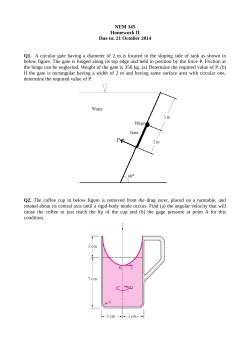
EPC9047 Quick Start Guide - Efficient Power Conversion
Development Board EPC9047 Quick Start Guide Half Bridge with Gate Drive for EPC2033 DESCRIPTION The EPC9047 development boards are in a half bridge topology with onboard gate drives, featuring the EPC2033 eGaN® field effect transistors (FETs). The purpose of these development boards is to simplify the evaluation process of these eGaN FETs by including all the critical components on a single board that can be easily connected into any existing converter. The development board is 2” x 1.5” and contains two eGaN FETs in a half bridge configuration using the Texas Instruments UCC27611 gate driver, supply and bypass capacitors. The board contains all critical components and layout for optimal switching performance. There are also various probe points to facilitate simple waveform measurement and efficiency calculation. A complete block diagram of the circuit is given in Figure 1. For more information on the EPC2033 eGaN FET please refer to the data sheet available from EPC at www.epc-co.com. The data sheet should be read in conjunction with this quick start guide. Table 1: Performance Summary (TA = 25°C) SYMBOL PARAMETER VDD Gate Drive Input Supply Range VIN CONDITIONS MIN MAX UNITS 7 12 V Bus Input Voltage Range 110 V VOUT Switch Node Output Voltage 150 V IOUT Switch Node Output Current 12* A VPWM PWM Logic Input Voltage Threshold Input ‘High’ Input ‘Low’ 3.5 0 6 1.5 V V Minimum ‘High’ State Input Pulse Width VPWM rise and fall time < 10ns 100 ns Minimum ‘Low’ State Input Pulse Width VPWM rise and fall time < 10ns 500# ns *Assumes inductive load, maximum current depends on die temperature – actual maximum current will be subject to switching frequency, bus voltage and thermal management. # Dependent on time needed to ‘refresh’ high side bootstrap supply voltage. For More Information: Please contact info@epc-co.com or your local sales representative Visit our website: www.epc-co.com Sign-up to receive EPC updates at bit.ly/EPCupdates or text “EPC” to 22828 EPC Products are distributed through Digi-Key. www.digikey.com Demonstration Board Notification EPC9047 boards are intended for product evaluation purposes only and are not intended for commercial use. As evaluation tools, they are not designed for compliance with the European Union directive on electromagnetic compatibility or any other such directives or regulations. As board builds are at times subject to product availability, it is possible that boards may contain components or assembly materials that are not RoHS compliant. Efficient Power Conversion Corporation (EPC) makes no guarantee that the purchased board is 100% RoHS compliant. No Licenses are implied or granted under any patent right or other intellectual property whatsoever. EPC assumes no liability for applications assistance, customer product design, software performance, or infringement of patents or any other intellectual property rights of any kind. EPC reserves the right at any time, without notice, to change said circuitry and specifications. EPC – EFFICIENT POWER CONVERSION CORPORATION | WWW.EPC-CO.COM | COPYRIGHT 2015 QUICK START GUIDE EPC9047 QUICK START PROCEDURE The development boards are easy to set up to evaluate the performance of the eGaN FET. Refer to Figure 2 for proper connect and measurement setup and follow the procedure below: 1. With power off, connect the input power supply bus to +VIN (J5, J6) and ground / return to –VIN (J7, J8). 2.With power off, connect the switch node of the half bridge OUT (J3, J4) to your circuit as required. 3. With power off, connect the gate drive input to +VDD (J1, Pin-1) and ground return to –VDD (J1, Pin-2). 4.With power off, connect the input PWM control signal to PWM (J2, Pin-1) and ground return to any of the remaining J2 pins. 5. Turn on the gate drive supply – make sure the supply is between 7 V and 12 V range. VDD Gate Drive Regulator Enable PWM Input 6. Turn on the bus voltage to the required value (do not exceed the absolute maximum voltage of 150 V on VOUT. 7. Turn on the controller / PWM input source and probe switching node to see switching operation. 8.Once operational, adjust the bus voltage and load PWM control within the operating range and observe the output switching behavior, efficiency and other parameters. 9. For shutdown, please follow steps in reverse. NOTE. When measuring the high frequency content switch node (OUT), care must be taken to avoid long ground leads. Measure the switch node (OUT) by placing the oscilloscope probe tip through the large via on the switch node (designed for this purpose) and grounding the probe directly across the GND terminals provided. See Figure 3 for proper scope probe technique. Gate Drive Supply Half Bridge with Bypass VIN Level shift, Dead-time Adjust and Gate Drive OUT Figure 1: Block Diagram of Development Board EPC – EFFICIENT POWER CONVERSION CORPORATION | WWW.EPC-CO.COM | COPYRIGHT 2015 | | PAGE 2 QUICK START GUIDE EPC9047 QUICK START PROCEDURE 7 V – 12 V _ 47, 150 Additional bus capacitance can be added on back VDD Supply + Gate Drive Supply (Note Polarity) A IIN + VIN _ Switch Node V (For Efficiency Measurement) + <110 V VIN Supply _ External Circuit PWM Input Figure 2: Proper Connection and Measurement Setup 47, 150 60 Do not use probe ground lead Ground probe against TP3 Minimize loop Place probe tip in large via at OUT Figure 3: Proper Measurement of Switch Node – OUT EPC – EFFICIENT POWER CONVERSION CORPORATION | WWW.EPC-CO.COM | COPYRIGHT 2015 | | PAGE 3 QUICK START GUIDE EPC9047 10 V 500 MHz ringing 1.9 ns rise time 8.7 ns fall time Figure 4 (a) – Rising Edge Figure 4 (b) – Falling Edge Figure 4: Typical Waveforms for EPC9047. VIN = 110 V to 5 V/12 A (100 kHz) Buck converter showing rising and falling edges, CH1: (VPWM) Input logic signal – CH2: (IOUT) Output inductor current – CH4: (VOUT) Switch node voltage THERMAL PERFORMANCE The EPC9047 development boards showcase the EPC2033 eGaN FETs. These development boards are intended for bench evaluation with low ambient temperature and convection cooling. The addition of heatsinking and forced air cooling can significantly increase the current rating Table 2: Bill of Materials Item Qty of these devices, but care must be taken to not exceed the absolute maximum die temperature of 150°C. NOTE. The EPC9047 development boards do not have any current or thermal protection on board. Reference Part Description Manufacturer / Part # 1 5 C1, C2, C3, C10, C11 Capacitor, 1 µF, 10%, 25 V, X5R Murata, GRM188R61E105KA12D 2 2 C6, C7 Capacitor, 100 pF, 5%, 50V, NP0 TDK, C1005X5R1E224K050BC 3 4 5 6 7 8 9 10 11 12 13 14 15 16 17 18 19 20 21 22 23 4 3 2 1 2 1 1 1 2 1 2 4 1 1 2 1 1 1 1 2 0 C8, C9, C12, C13 C16, C17, C18 D1, D2 D3 D4, D5 J1 J2 J3, J4, J5, J6, J7, J8 Q1, Q2 R1 R11, R12 R2, R3, R6, R15 R4 R5 TP1, TP2 TP3 U1 U2 U4 U6, U7 P1, P2 Capacitor, 0.22 µF, 10%, 25 V, X5R Capacitor, 0.1 µF, 10%, 250 V, X7S Schottky Diode, 30 V Diode, 200 V Diode, 40 V Connector Connector Connector eGaN® FET Resistor, 10.0 K, 5%, 1/8 W Resistor, 1 Ohm, 1%, 1/16 W Resistor, 0 Ohm, 1/8 W Resistor, 150 Ohm, 1%, 1/8 W Resistor, 470 Ohm, 1%, 1/8 W Test Point Connector I.C., Logic 400 LFM I.C., Opto-coupler I.C., Logic I.C., Gate driver Optional potentiometer TDK, C2012X7T2E104K125AA C2012X7T2E104K125AA Diodes Inc., SDM03U40-7 Diodes Inc.,BAV21WS-7-F Diodes Inc.,BAS40LP-7 2pins of Tyco, 4-103185-0 4pins of Tyco, 4-103185-0 FCI, 68602-224HLF EPC2033 Stackpole, RMCF0603FT10K0 Stackpole, RMCF0402FT1R00 Stackpole, RMCF0603ZT00R0 Stackpole, RMCF0603FT150R Stackpole, RMCF0603FT470R Keystone Elect, 5015 1/40th of Tyco, 4-103185-0 Fairchild, NC7SZ00L6X Silicon Labs, Si8610BC Fairchild, NC7SZ08L6X Texas Instruments, UCC27611 24 0 R14 Optional resistor 25 0 U5 Optional I.C. EPC – EFFICIENT POWER CONVERSION CORPORATION | WWW.EPC-CO.COM | COPYRIGHT 2015 | | PAGE 4 QUICK START GUIDE EPC9047 7 - 12 Vdc J1 D3 VDD 1 2 R6 Zero BAV21 CON2 C10 1μF, 25V PWM1 J2 PWM1 1 2 CON2 J9 1 2 R1 10k 1 2 3 CON2 U1 A VDD B 5 GND NC7SZ00L6X GND Y 6 VCC VCC 4 C11 1μF, 25V DZH 1 C2 1μF, 25V 5 U4 A 2 B 3 GND VDD 2 7 6 4 Optional R15 Zero DL VREF 5 4 3 5 6 VSS UCC27611 7 GDH1 D4 BAS40LP 1 ohm J3 CON4 1 2 3 4 SW OUT SDM03U40 R4 DH VCC VCC 1 470 DRL C3 C7 J6 CON4 Q1 SW OUT 2 SDM03U40 R5 4 3 2 1 EPC2033 GDH GDH2 R11 110V Max 1μF, 25V U5 Zero 8 2 7 3 6 4 5 Optional C9 0.22μF, 25V DRLT 1 VDD LDO 2 VREF 6 5 4 3 UCC27611 TP3 0.22μF, 25V U7 1 0.22μF, 250V J4 CON4 C13 VDD C16 C17 C18 4 3 2 1 150 D2 R14 2 C8 0.22μF, 25V SS8610BC R3 P2 Optional C1 1μF, 25V DRHT LDO D1 NC7SZ08L6X PWM2 VDD 1 J5 CON4 1 2 3 4 C12 0.22μF, 25V U6 8 P1 2 Optional 6 5 Y U2 C6 3 100p 4 DRH R2 Zero 1 PWM1 PWM2 TP2 Keystone 5015 1 BC VSS 7 D5 BAS40LP GDL1 CON1 EPC9047 GDL Q2 GDL2 J7 CON4 1 2 3 4 R12 1 ohm 100p GND GND 1 TP1 Keystone 5015 GND 4 3 2 1 J8 CON4 Figure 5: Development Board Schematic EPC – EFFICIENT POWER CONVERSION CORPORATION | WWW.EPC-CO.COM | COPYRIGHT 2015 | | PAGE 5
© Copyright 2025













